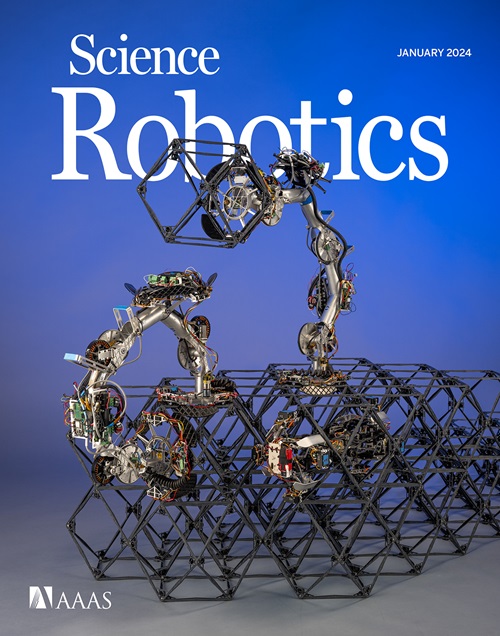Robotic locomotion through active and passive morphological adaptation in extreme outdoor environments
IF 27.5
1区 计算机科学
Q1 ROBOTICS
引用次数: 0
Abstract
Robotic locomotion has shown substantial advancements, yet robots still lack the versatility and agility shown by animals navigating complex terrains. This limits their applicability in complex environments where they could be highly beneficial. Unlike existing robots that rely on intricate perception systems to construct models of both themselves and their surroundings, a more bioinspired approach leverages reconfiguration to adapt a robot’s morphology to its environment. Although interest in such multimodal, terrain-adaptive robots is increasing, their capacity for morphological reconfiguration often remains confined to specific body parts or comes at the expense of increased system complexity and reduced locomotion efficiency. Our study seeks to enhance robotic locomotion by developing robots that can actively reconfigure their morphology, altering their physical properties and leveraging their adaptability to navigate efficiently in diverse environments. We demonstrate how combining a compliant structure with morphological reconfiguration allowed a robot to transition between flat and spherical forms, enabling autonomous, multimodal locomotion—driving, rolling, and swimming—across complex terrains with minimal sensing. By actively reconfiguring its morphology to adapt physical properties for compliant interactions, the robot enhanced locomotion across rough, diverse environments. Leveraging its adaptability in different locomotion modes to navigate a 4.5-kilometer path across mountainous, aquatic, and urban terrains, the robot outperformed traditional and multimodal robots in terms of versatility, energy efficiency, and robustness. Developing versatile, energy-efficient, compliant robots capable of reconfiguring their morphology could substantially enhance autonomous navigation, opening up broader applications in unstructured environments, from environmental monitoring to disaster response and extraterrestrial exploration.机器人运动通过主动和被动形态适应在极端室外环境
机器人的运动已经显示出了实质性的进步,但机器人仍然缺乏动物在复杂地形上行驶时所表现出的多功能性和敏捷性。这限制了它们在复杂环境中的适用性,而在复杂环境中它们可能非常有益。现有的机器人依赖于复杂的感知系统来构建自身和周围环境的模型,与之不同的是,一种更受生物启发的方法利用重构来调整机器人的形态以适应其环境。尽管人们对这种多模式、地形自适应机器人的兴趣越来越大,但它们的形态重构能力往往局限于特定的身体部位,或者是以增加系统复杂性和降低运动效率为代价的。我们的研究旨在通过开发能够主动重新配置其形态,改变其物理特性并利用其适应性在不同环境中有效导航的机器人来增强机器人运动。我们展示了如何将柔性结构与形态重构相结合,使机器人能够在平面和球形之间转换,实现自主,多模式运动-驾驶,滚动和游泳-通过最小的传感复杂地形。通过主动重新配置其形态以适应柔性相互作用的物理特性,机器人增强了在粗糙,多样化环境中的运动。利用其在不同运动模式下的适应性,在山区、水生和城市地形上行驶4.5公里的路径,机器人在多功能性、能效和鲁棒性方面优于传统的多模式机器人。开发多功能、节能、兼容的机器人,能够重新配置其形态,可以大大增强自主导航,在非结构化环境中开辟更广泛的应用,从环境监测到灾难响应和地外探索。
本文章由计算机程序翻译,如有差异,请以英文原文为准。
求助全文
约1分钟内获得全文
求助全文
来源期刊

Science Robotics
Mathematics-Control and Optimization
CiteScore
30.60
自引率
2.80%
发文量
83
期刊介绍:
Science Robotics publishes original, peer-reviewed, science- or engineering-based research articles that advance the field of robotics. The journal also features editor-commissioned Reviews. An international team of academic editors holds Science Robotics articles to the same high-quality standard that is the hallmark of the Science family of journals.
Sub-topics include: actuators, advanced materials, artificial Intelligence, autonomous vehicles, bio-inspired design, exoskeletons, fabrication, field robotics, human-robot interaction, humanoids, industrial robotics, kinematics, machine learning, material science, medical technology, motion planning and control, micro- and nano-robotics, multi-robot control, sensors, service robotics, social and ethical issues, soft robotics, and space, planetary and undersea exploration.
 求助内容:
求助内容: 应助结果提醒方式:
应助结果提醒方式:


